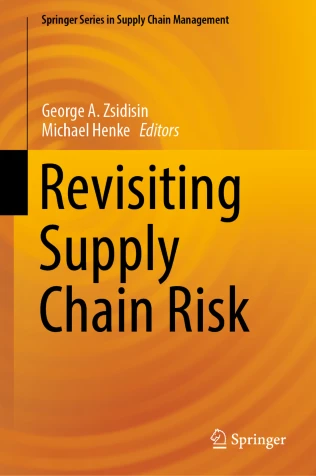 Supply Chain Risk Management (SCRM) is still a hot
topic, where many companies are lacking implementation. However,
researchers around the world are working on ways how supply chains can
be designed in a way, so that they are (more) resilient. Within this
context, George Zsidisin and Michael Henke compiled state-of-the-art expertise from a variety of researchers, all involved in SCRM, to publish “Revisiting Supply Chain Risk“.
Supply Chain Risk Management (SCRM) is still a hot
topic, where many companies are lacking implementation. However,
researchers around the world are working on ways how supply chains can
be designed in a way, so that they are (more) resilient. Within this
context, George Zsidisin and Michael Henke compiled state-of-the-art expertise from a variety of researchers, all involved in SCRM, to publish “Revisiting Supply Chain Risk“.
“This book offers a bridge between our current understanding of supply chain risk in practice and theory, and the monumental shifts caused by the emergence of the fourth industrial revolution. Supply chain risk and its management have experienced significant attention in scholarship and practice over the past twenty years. Our understanding of supply chain risk and its many facets, such as uncertainty and vulnerability, has expanded beyond utilizing approaches such as deploying inventory to buffer the initial effects of disruptions. Even with our increased knowledge of supply chain risk, being in the era of lean supply chain practices, digitally managed global supply chains, and closely interconnected networks, firms are exposed as ever to supply chain uncertainties that can damage, or even destroy, their ability to compete in the marketplace. The book acknowledges the criticality of big data analytics in Supply Chain Risk Management (SCRM) processes and provides appropriate tools and approaches for creating robust SCRM processes. Revisiting Supply Chain Risk presents a state-of-the-art look at SCRM through current research and philosophical thought. It is divided into six sections that highlight established themes, as well as provide new insights to developing areas of inquiry and contexts on the topic. Section 1 examines the first step in managing supply chain risk, risk assessment. The chapters in Section 2 encompass resiliency in supply chains, while Section 3 looks at relational and behavioral perspectives from varying units of analysis including consortiums, teams and decision makers. Section 4 focuses on examining supply chain risk in the contexts of sustainability and innovation. Section 5 provides insight on emerging typologies and taxonomies for classifying supply chain risk. The book concludes with Section 6, featuring illustrative case studies as real-world examples in assessing and managing supply chain risk.” (Source: Springer website, https://www.springer.com/us/book/978303003812)
I am extremely grateful that I could contribute a chapter to this book, written together with Sascha Düerkop, researcher at Fulda University of Applied Science. Our chapter “Risk Management of Critical Logistical Infrastructures: Securing the Basis for Effective and Efficient Supply Chains” was developed based on research on critical infrastructures (RIMA-KIL, BARM-KIL).
Zsidisin, G. A./Henke, M. (Eds.): Revisiting Supply Chain Risk, Springer, 2019.
